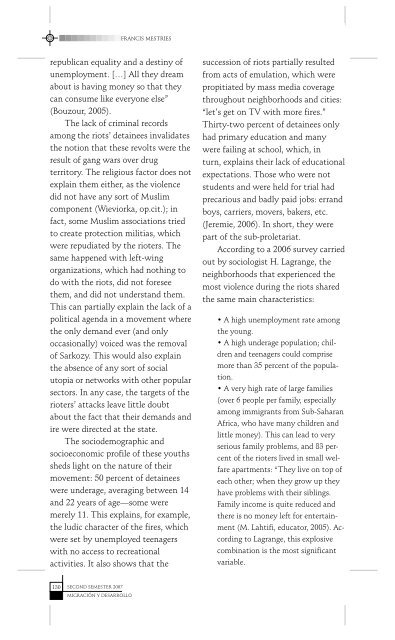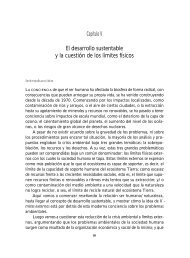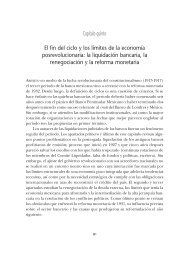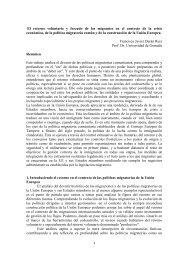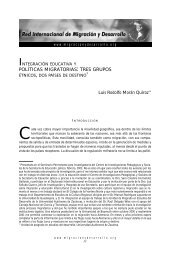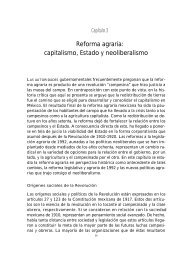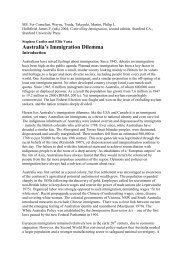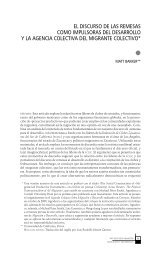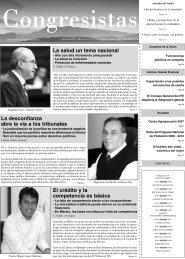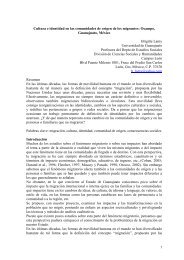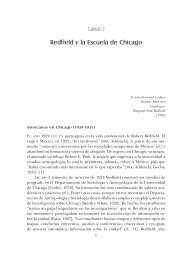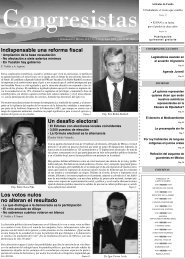the french autumn riots of 2005 and the crisis of republican integration
the french autumn riots of 2005 and the crisis of republican integration
the french autumn riots of 2005 and the crisis of republican integration
Create successful ePaper yourself
Turn your PDF publications into a flip-book with our unique Google optimized e-Paper software.
FRANCIS MESTRIES<strong>republican</strong> equality <strong>and</strong> a destiny <strong>of</strong>unemployment. […] All <strong>the</strong>y dreamabout is having money so that <strong>the</strong>ycan consume like everyone else”(Bouzour, <strong>2005</strong>).The lack <strong>of</strong> criminal recordsamong <strong>the</strong> <strong>riots</strong>’ detainees invalidates<strong>the</strong> notion that <strong>the</strong>se revolts were <strong>the</strong>result <strong>of</strong> gang wars over drugterritory. The religious factor does notexplain <strong>the</strong>m ei<strong>the</strong>r, as <strong>the</strong> violencedid not have any sort <strong>of</strong> Muslimcomponent (Wieviorka, op.cit.); infact, some Muslim associations triedto create protection militias, whichwere repudiated by <strong>the</strong> rioters. Thesame happened with left-wingorganizations, which had nothing todo with <strong>the</strong> <strong>riots</strong>, did not foresee<strong>the</strong>m, <strong>and</strong> did not underst<strong>and</strong> <strong>the</strong>m.This can partially explain <strong>the</strong> lack <strong>of</strong> apolitical agenda in a movement where<strong>the</strong> only dem<strong>and</strong> ever (<strong>and</strong> onlyoccasionally) voiced was <strong>the</strong> removal<strong>of</strong> Sarkozy. This would also explain<strong>the</strong> absence <strong>of</strong> any sort <strong>of</strong> socialutopia or networks with o<strong>the</strong>r popularsectors. In any case, <strong>the</strong> targets <strong>of</strong> <strong>the</strong>rioters’ attacks leave little doubtabout <strong>the</strong> fact that <strong>the</strong>ir dem<strong>and</strong>s <strong>and</strong>ire were directed at <strong>the</strong> state.The sociodemographic <strong>and</strong>socioeconomic pr<strong>of</strong>ile <strong>of</strong> <strong>the</strong>se youthssheds light on <strong>the</strong> nature <strong>of</strong> <strong>the</strong>irmovement: 50 percent <strong>of</strong> detaineeswere underage, averaging between 14<strong>and</strong> 22 years <strong>of</strong> age—some weremerely 11. This explains, for example,<strong>the</strong> ludic character <strong>of</strong> <strong>the</strong> fires, whichwere set by unemployed teenagerswith no access to recreationalactivities. It also shows that <strong>the</strong>succession <strong>of</strong> <strong>riots</strong> partially resultedfrom acts <strong>of</strong> emulation, which werepropitiated by mass media coveragethroughout neighborhoods <strong>and</strong> cities:“let’s get on TV with more fires.”Thirty-two percent <strong>of</strong> detainees onlyhad primary education <strong>and</strong> manywere failing at school, which, inturn, explains <strong>the</strong>ir lack <strong>of</strong> educationalexpectations. Those who were notstudents <strong>and</strong> were held for trial hadprecarious <strong>and</strong> badly paid jobs: err<strong>and</strong>boys, carriers, movers, bakers, etc.(Jeremie, 2006). In short, <strong>the</strong>y werepart <strong>of</strong> <strong>the</strong> sub-proletariat.According to a 2006 survey carriedout by sociologist H. Lagrange, <strong>the</strong>neighborhoods that experienced <strong>the</strong>most violence during <strong>the</strong> <strong>riots</strong> shared<strong>the</strong> same main characteristics:• A high unemployment rate among<strong>the</strong> young.• A high underage population; children<strong>and</strong> teenagers could comprisemore than 35 percent <strong>of</strong> <strong>the</strong> population.• A very high rate <strong>of</strong> large families(over 6 people per family, especiallyamong immigrants from Sub-SaharanAfrica, who have many children <strong>and</strong>little money). This can lead to veryserious family problems, <strong>and</strong> 83 percent<strong>of</strong> <strong>the</strong> rioters lived in small welfareapartments: “They live on top <strong>of</strong>each o<strong>the</strong>r; when <strong>the</strong>y grow up <strong>the</strong>yhave problems with <strong>the</strong>ir siblings.Family income is quite reduced <strong>and</strong><strong>the</strong>re is no money left for entertainment(M. Lahtifi, educator, <strong>2005</strong>). Accordingto Lagrange, this explosivecombination is <strong>the</strong> most significantvariable.130SECOND SEMESTER 2007MIGRACIÓN Y DESARROLLO


